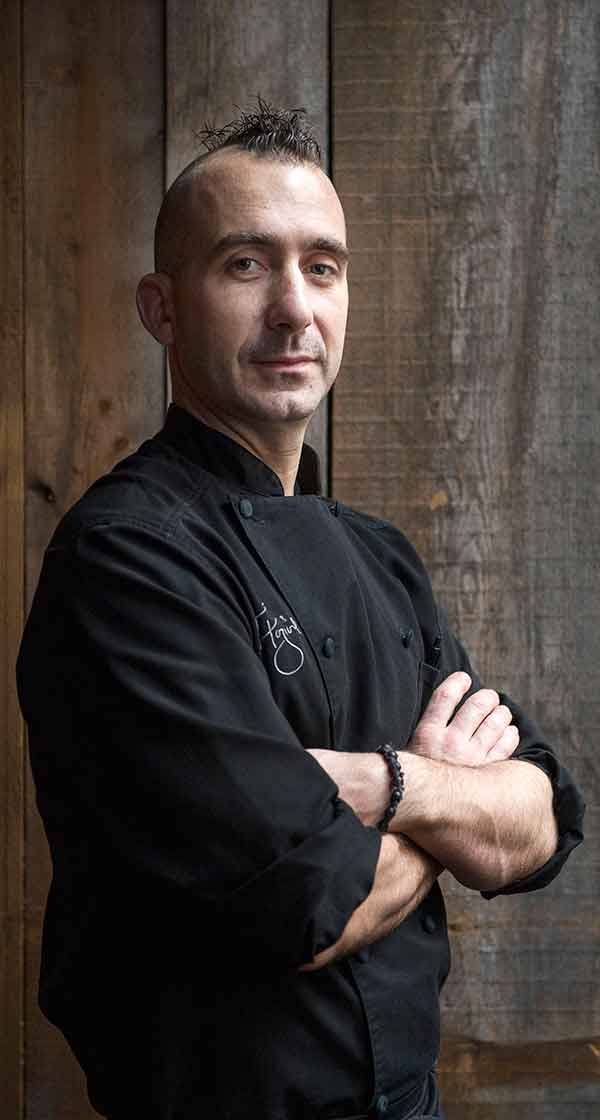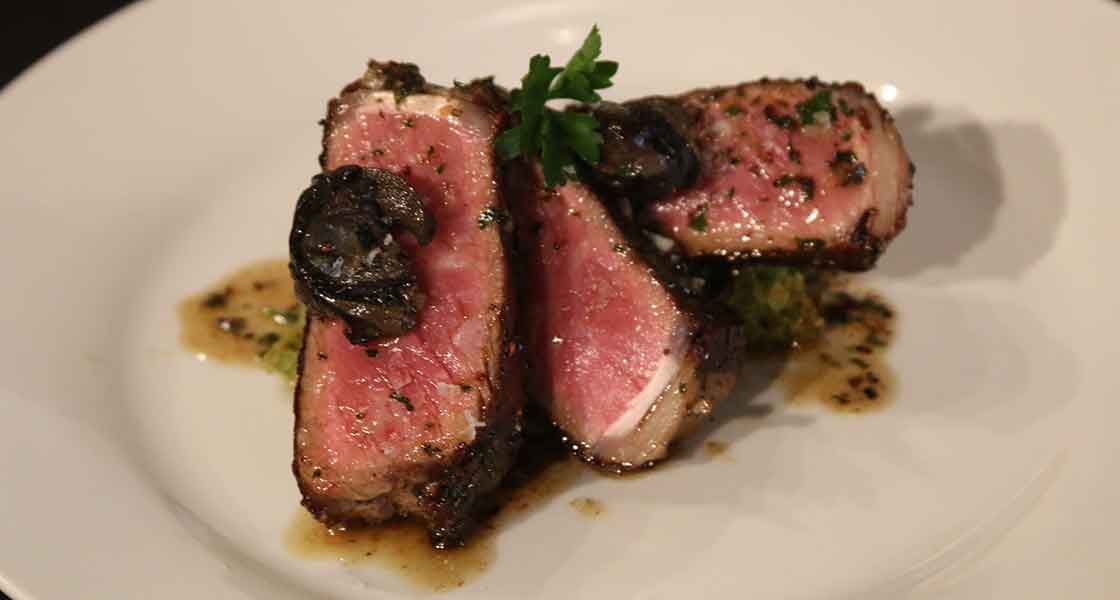Chef Marc Forgione Forges His Own Path
CULINARY POINT OF VIEW
 Chef Marc “Forge” Forgione began his career at the age of 16, joining his father, Larry Forgione (a culinary legend), in the kitchen at An American Place. After a culinary apprenticeship in France cemented that he did want to follow in his father’s footsteps, Chef Forgione opened his eponymous restaurant just as the Great Recession began in 2008. He managed to keep the restaurant afloat and his efforts were rewarded in 2010 when the restaurant received its first Michelin star. That same year, he was crowned Food Network’s Next Iron Chef. No longer just the son of culinary legend, Forgione has created his own unique culinary identity.
Chef Marc “Forge” Forgione began his career at the age of 16, joining his father, Larry Forgione (a culinary legend), in the kitchen at An American Place. After a culinary apprenticeship in France cemented that he did want to follow in his father’s footsteps, Chef Forgione opened his eponymous restaurant just as the Great Recession began in 2008. He managed to keep the restaurant afloat and his efforts were rewarded in 2010 when the restaurant received its first Michelin star. That same year, he was crowned Food Network’s Next Iron Chef. No longer just the son of culinary legend, Forgione has created his own unique culinary identity.
Kelly Hensel: Although you had been working in kitchens since a teenager, you said that it was your apprenticeship in France where you first felt a visceral connection with food. What was it about your experience there that reinforced your desire to be a chef?
Marc Forgione: Well when I was in France there was very little distraction. Especially compared to working and living in New York City in your early 20’s. The little village in France where I worked had literally four stores—a laundromat, pharmacy, a tiny restaurant, and a bakery. There were only 400 people living there and no one spoke English. I was by myself and I couldn’t have a conversation with anybody. I didn’t have TV, phone, or computer. So I didn’t have really much of a choice but to focus on cooking. I just started to really focus on technique and ingredients, and it ended up laying the groundwork for who I wanted to be.
Hensel: Did you ever consider getting a culinary degree as opposed to, or in addition to, your degree in hotel and restaurant management?
Forgione: No. When I went to college, I didn’t go to become a chef. I was actually going to college to see if maybe there was something else out there in the world besides food. I was 18 and obviously I had already worked in restaurants, but at that time I thought maybe I didn’t want to do what my dad does [father is chef Larry Forgione who has been called “The Godfather of American Cuisine”]. So in school I majored in forestry my first year, psychology my second year … I was just exploring different things.
To be honest, I really just went into hotel and restaurant management to get a degree. It wasn’t like I had this shining moment when I was 18 and thought, oh yeah, I’m going to be a chef. I was in school, having fun, and just needed to graduate with something. It turned out coincidentally that the Hotel, Restaurant, and Travel Administration program was very highly regarded at UMass [University of Massachusetts Amherst].
Hensel: You faced a number of challenges opening your eponymous restaurant. What was one major learning that you took away from that time?
Forgione: To follow your gut. I think the hardest thing to do in anything, not just cooking, is to trust yourself. When I opened my restaurant, a lot of people were telling me to change the concept and turn it into a bistro. We had a lease and we were losing money. People kept telling [me] the fine dining thing wasn’t working, but I made a conscious decision that if we’re going to go down, I’d rather go down fighting for who we are. That was the hardest part … sticking to my guns no matter how many people around me—people that loved me and people that were my business partners—were telling me to change.

Hensel: You worked as corporate chef for the BLT Restaurant Group for a while before you opened your own restaurant. How did that job differ from being a restaurant chef?
Forgione: It was actually one of the best and hardest things that I ever had to do because as a chef you have a certain routine. You come in everyday and check the reservations, the food quality, and the specials. But when you’re a corporate chef, all of a sudden that routine gets thrown out the window. Now you have to be really organized and are constantly on the go because you are in charge of seven different restaurants. It was a really great learning experience, and I don’t think I would have been able to open my own restaurant at such a young age if I hadn’t done that. But for me, it takes a little bit of the soul out of the cooking part of it. I just wanted to get back into the kitchen on a daily basis.
Hensel: Now you consult for groups like the United Sorghum Checkoff Program. What does your work with them entail?Forgione: I do get approached quite a bit by different groups, and if I like the product and what the organization is trying to achieve, then I will try to help. I think United Sorghum is a great example. Sorghum is an ancient grain and when cooked the right way it can be a nice healthy alternative. And it tastes good.
Hensel: Did you work with sorghum as an ingredient before partnering with United Sorghum?
Forgione: We were serving sorghum popcorn as a bar snack at American Cut [Forgione’s modern steakhouse restaurant brand]. I don’t know if you’ve ever seen sorghum popcorn, but it’s tiny, mini popcorn—you can fit like 100 in your hand. But other than the popcorn, no, I hadn’t really been using it. Since I started working with the group, I have learned more about sorghum syrup and now I have some in my basement at the restaurant.
Hensel: With chefs, like yourself, considered celebrities in today’s culture, there has been a huge influx of young people entering the culinary field. You’re very honest about the struggles you faced at the beginning of your career. What advice would you give to aspiring chefs?
Forgione: First and foremost, any time I have a young kid who’s looking for a job and says, “I want to be on TV someday,” I tell them that, “You’re working in the wrong profession. Go to acting school because being a chef is not about being on TV.” When I was 23, trust me when I tell you, being on TV was not part of my plan. Even now, it [being on Food Network’s Iron Chef] only takes about five days out of my year.
It’s not about being on TV—it’s about having passion for what you do. Make sure that you love it. I tell that to every young person in this business. If you’re a young kid and you have any doubt whatsoever about being a cook, don’t waste your time, because you’ll get chewed up and spit out. It’s a hard business. But if you love what you do, you’re not really working. There’s fun and camaraderie and not one day is ever exactly the same.
TV should not be the pinnacle of where kids are trying to get these days. Owning your own restaurant or being a chef of a restaurant should be what’s at the end of the rainbow for them. I was actually joking the other day that I want to have a TV show that shows people that it’s not about being on TV.

Strip Steak, Escargot, and Braised Lettuce with Sorghum Air Bread
Serves 4
For the Marinade:
1/3 cup chopped fresh curly parsley
1 tablespoons minced shallot
2 teaspoons chopped fresh rosemary
1 teaspoon chopped fresh thyme
1/2 garlic clove, minced
1/2 teaspoon pink peppercorns, crushed
Extra-virgin olive oil
For the Strip Steak:
Four (12 oz) dry-aged strip steak, about 1.5 inches thick
Kosher salt
Freshly ground black pepper
Canola oil
4 oz (8 tbsp) unsalted butter
1 head garlic, halved horizontally
6 sprigs fresh thyme
- Combine all herbs, shallots, garlic, and peppercorns in a small container and cover with enough EVOO to cover the herb mixture. Measure out ½ cup of the marinade and pour into a large plastic bag or re-sealable container. Add the steaks and marinate overnight or up to one day ahead.
- Pat the steak dry and season both sides liberally with salt and pepper. Let the steak come to room temperature before cooking.
- Add enough oil to a large sauté pan, add the steak and sear for 1 minute. Reduce the heat to medium-high and cook the steak, without moving it, for about 4 min. Check the bottom of the steak to see if it is charred to your liking; if it is, flip it over, and cook the other side for 4 min. Add the butter, garlic, and thyme to the pan and baste the steak in the butter for about 2 min.
- Transfer the steak to a plate and let it rest for 10 min before serving. When ready to serve, slice the steak across the grain.
For the Escargot Butter:
8 oz (16 tbsp) unsalted butter, softened
4 tbsp finely chopped fresh curly parsley
1 shallot, finely chopped
2 tbsp chopped fresh chives
½ garlic clove
Kosher salt
Freshly ground black pepper
- Place the butter, parsley, shallot, chives, garlic, salt, and pepper in a bowl of a stand mixer fitted with a paddle attachment. Mix on medium speed until incorporated and green. Wrap the butter in plastic wrap and refrigerate or freeze until needed.
For the Sorghum Air Bread:
75 g sorghum flour
½ tsp xantham gum
50 g milk
3 eggs
5 g salt
50 g green puree (recipe follows)
50 g melted butter
- Whisk together all ingredients. Put in an iSi cannister and charge with 2 cartridges of NO2. Squeeze out into Pam sprayed paper cups and microwave each for 1.5 min. After removing, invert onto sheet trays. Tear each piece of bread into 1-inch pieces (TEAR, DO NOT CUT/SLICE).
- Place in oven until outside is crispy
For the Green Puree:
5 lb spinach
3 cloves garlic, minced
1 whole clove of garlic
- Heat a little oil in a pan and sauté the minced garlic until brown and then add spinach. Spread out onto a sheet tray and cool immediately in the fridge.
- Once cooled, puree in a blender with one whole clove of garlic for about 45 seconds until it turns bright green. Pour the puree into a bowl set over another bowl filled with ice and whisk until cold. Pass through a chinois.
For the Escargot:
1 can land snails, drained and rinsed
1 cups white wine
1/4 bunch thyme
1 fresh bay leaves
½ head of garlic
2 tbsp escargot butter
Canola oil
Salt
2 tbsp chopped parsley
- In a sauté pan and heat over medium-high until smoking. Add the snails in a single layer and cook until liquid is released. Add the herbs and garlic and cook for an additional minute. Add white wine and deglaze. Season to taste with salt. Cook until the snails have a light sear. Cool on a sheet pan lined with parchment.
- Drain and pat dry the snails. Add 2 tbsp of the escargot butter and cook the snails until they have a nice sear on one side. Stir until the butter turns brown and then remove from heat immediately. Toss with chopped parsley.
For the Escarole:
Blended Oil
1 oz (2 tbsp) unsalted butter
2 garlic cloves, sliced
1 lb escarole, roughly chopped
1 tsp red pepper flakes
Kosher salt
- Add enough oil to a medium skillet to cover the bottom of the pan. Add the garlic and cook until the garlic is toasted, about 1 min. Add the escarole, red pepper flakes, a few pinches of salt, and 1 tbsp of water. Stir to distribute, and cook until the greens are wilted and the water has evaporated, about 1 min. Transfer the contents of the pan to a paper towel–lined plate and set aside.
To assemble:
Maldon salt
Flat leaf parsley leaves
Sherry Vinegar
To assemble:
- Arrange two pieces of the air bread on the plate, place a pile of escarole in the middle, arrange slices of strip steak on top. Top steak slices with 3 pieces of escargot and butter on top. Finish with Maldon, flat leaf parsley leaves, and drizzle of sherry vinegar.


